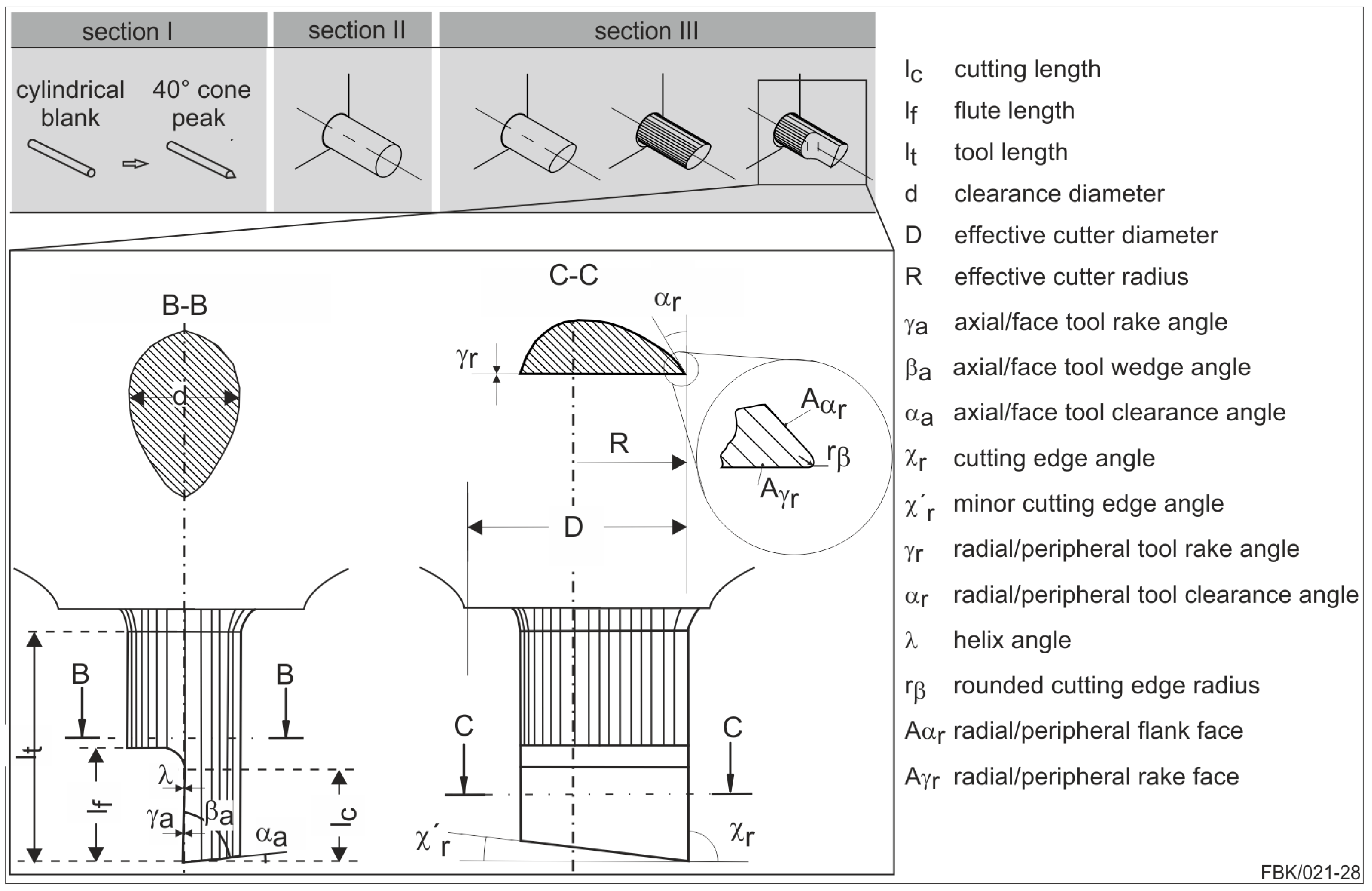Application of Ultra-Small Micro Grinding and Micro Milling Tools: Possibilities and Limitations
Abstract
:1. Introduction
2. Materials and Methods
2.1. Micro Milling Center
2.2. Precision 4-Axes Machine
2.3. Manufacturing of Micro End Mils (MEMs)
2.4. Manufacturing of Micro Pencil Grinding Tools (MPGTs)
3. Results
3.1. Electroless Plating of Micro Pencil Grinding Tools
3.2. A Case Study in Micro Grinding
3.3. Manufacturing of Ultra Small Diameter Micro Milling Tools
3.4. A Case Study in Micro milling—Influnece of Cemented Carbide Specifications
4. Conclusions
Acknowledgments
Author Contributions
Conflicts of Interest
References
- Aurich, J.C.; Schneider, F.; Mayer, P.; Kirsch, B.; Hasse, H. Oberflächenerzeugungs-Morphologie-Eigenschafts-Beziehungen. ZWF 2016, 111, 213–216. [Google Scholar] [CrossRef]
- Byun, J.M.; Bang, S.-R.; Kim, H.W.; Kim, T.-Y.; Hong, S.-J.; Kim, Y.D. Effect of heat treatment on corrosion resistance and adhesion property in Zn-Mg-Zn multi-layer coated steel prepared by PVD process. Surf. Coat. Technol. 2017, 309, 1010–1014. [Google Scholar] [CrossRef]
- Aloraier, A.S.; Joshi, S.; Price, J.W.H.; Alawadhi, K. Hardness, Microstructure, and Residual Stresses in Low Carbon Steel Welding with Post-weld Heat Treatment and Temper Bead Welding. Metall. Mat. Trans. A 2014, 45, 2030–2037. [Google Scholar] [CrossRef]
- Smaga, M.; Beck, T.; Arrabiyeh, P.; Reichenbach, I.; Kirsch, B.; Aurich, J.C.; Schryvers, N.; van Humbeeck, J. Characterization of micro machined surface from TRIP/TWIP steels. MATEC Web Conf. 2015, 33, 07004. [Google Scholar] [CrossRef]
- Buhl, S.; Schmidt, K.; Sappok, D.; Merz, R.; Godard, C.; Kerscher, E.; Kopnarski, M.; Sauer, B.; Antonyuk, S.; Ripperger, S. Surface structuring of case hardened chain pins by cold-sprayed microparticles to modify friction and wear properties. Particuology 2015, 21, 32–40. [Google Scholar] [CrossRef]
- Godard, C.; Bohley, M.; Aurich, J.C.; Kerscher, E. Deformation behaviour of micro-milled cp-titanium specimens under tensile loading. IJMR 2015, 106, 572–579. [Google Scholar] [CrossRef]
- Schlegel, C. Produktive Biofilme auf Mikrostrukturierten Metalloberflächen, 1. Aufl. ed.; Cuvillier: Göttingen, Niedersachs, 2016. [Google Scholar]
- Aurich, J.C.; Bohley, M.; Schneider, F.; Kirsch, B. Hartmetallwerkzeuge für die Mikrobearbeitung. Einflussgrößen auf das Bearbeitungsergebnis. In Pulvermetallurgie in Wissenschaft und Praxis Band 32, Proceedings of the Hagener Symposium—Zerspanung von und Mit Pullvermetallurgischen Werkstoffen, Hagen, Germany, 24–25 November 2016; Heimdall: Rheine, Germany, 2016. [Google Scholar]
- Feng, J. Microgrinding of Ceramic Materials. Ph.D. Thesis, University of Michigan, Ann Arbor, MI, USA, 2010. [Google Scholar]
- Pratap, A.; Patra, K.; Dyakonov, A.A. Manufacturing Miniature Products by Micro-grinding: A Review. Procedia Eng. 2016, 150, 969–974. [Google Scholar] [CrossRef]
- Engmann, J. Galvanisch Gebundene Mikroschleifstifte. Entwicklung, Herstellung und Einsatz, Als Ms. gedr; Produktionstechnische Berichte aus dem FBK 01/2011; Techn. Univ: Kaiserslautern, Germany, 2011. [Google Scholar]
- Ohnishi, O.; Onikura, H.; Min, S.K.; Aziz, M.; Tsuruoka, S. Characteristics of grooving by micro end mills with various tool shapes and approach to their optimal shape. Mem. Fac. Eng. Kyushu Univ. 2007, 67, 143–151. [Google Scholar]
- Denkena, B.; Leon, L.; de Kästner, J. Burr Formation in Microstructuring Processes. In Burrs—Analysis, Control and Removal; Aurich, J.C., Dornfeld, D., Eds.; Springer: Berlin/Heidelberg, Germany, 2010; pp. 55–62. [Google Scholar]
- Aurich, J.C.; Carrella, M.; Walk, M. Micro grinding with ultra small micro pencil grinding tools using an integrated machine tool. CIRP Ann. Manuf. Technol. 2015, 64, 325–328. [Google Scholar] [CrossRef]
- Aurich, J.C.; Reichenbach, I.G.; Schueler, G.M. Manufacture and application of ultra-small micro end mills. CIRP Ann. Manuf. Technol. 2012, 61, 83–86. [Google Scholar] [CrossRef]
- Park, H.-K.; Onikura, H.; Ohnishi, O.; Sharifuddin, A. Development of micro-diamond tools through electroless composite plating and investigation into micro-machining characteristics. Precis. Eng. 2010, 34, 376–386. [Google Scholar] [CrossRef]
- Aurich, J.; Reichenbach, I.; Bohley, M. Ultra-small Micro End Mills. In CIRP Encyclopedia of Production Engineering; Laperrière, L., Reinhart, G., Eds.; Springer: Berlin/Heidelberg, Germany, 2014; pp. 1280–1286. [Google Scholar]
- Bohley, M.; Reichenbach, I.G.; Müller, C.; Aurich, J.C. Development of a desktop machine tool for integrated ultra-small micro end mill production and application. In Proceedings of the 11th International Conference on Micromachining, Orange County, CA, USA, 29–31 March 2016; pp. 1–6. [Google Scholar]
- Aurich, J.C.; Bohley, M.; Reichenbach, I.G.; Kirsch, B. Surface quality in micro milling: Influences of spindle and cutting parameters. CIRP Ann. Manuf. Technol. 2017. [Google Scholar] [CrossRef]
- Aurich, J.C.; Kirsch, B. Grinding Wheel. In CIRP Encyclopedia of Production Engineering; Springer Science+Business Media: Berlin, Germany, 2014. [Google Scholar]
- Wei, C.; Hu, D.; Xu, K.; Ni, J. Electrochemical discharge dressing of metal bond micro-grinding tools. Int. J. Mach. Tools Manuf. 2011, 51, 165–168. [Google Scholar] [CrossRef]
- Messekompakt.de. Extrem Kleiner Gesinterter Schleifstift mit 0.18 mm Durchmesser. Available online: https://www.messekompakt.de/toptencms/dateien/Messen-Bilder%202014/2014-1/GrindTec_2014/messekompakt_NEWS_zur_GrindTec_2014_Beleg.pdf (accessed on 22 August 2017).
- Gäbler, J.; Pleger, S. Precision and micro CVD diamond-coated grinding tools. Int. J. Mach. Tools Manuf. 2010, 50, 420–424. [Google Scholar] [CrossRef]
- Hoffmeister, H.-W.; Wittmer, R. Mikroschleifen sprödharter Werkstoffe Stichworte. wt Werkstattstech. Online 2010, 11, 837–841. [Google Scholar]
- Hoffmeister, H.-W.; Illenseer, S.; Gäbler, J. CVD-Diamantschleifstifte für den Werkzeug- und Formenbau. Vak. Forsch. Praxis 2004, 2, 72–78. [Google Scholar] [CrossRef]
- Onikura, H.; Ohnishi, O.; Take, Y.; Kobayashi, A. Fabrication of Micro Carbide Tools by Ultrasonic Vibration Grinding. CIRP Ann. Manuf. Technol. 2000, 49, 257–260. [Google Scholar] [CrossRef]
- Arrabiyeh, P.A.; Kirsch, B.; Aurich, J.C. Development of Micro Pencil Grinding Tools via an Electroless Plating Process. J. Micro Nano-Manuf. 2017, 5, 011002. [Google Scholar] [CrossRef]
- Chen, S.-T.; Tsai, M.-Y.; Lai, Y.-C.; Liu, C.-C. Development of a micro diamond grinding tool by compound process. J. Mater. Proc. Technol. 2009, 209, 4698–4703. [Google Scholar] [CrossRef]
- Geometrical Product Specifications (GPS)—Surface Texture: Profile Method—Terms, Definitions and Surface Texture Parameters; International Organization for Standardization: Geneva, Switzerland, 1997.
- Reichenbach, I.G. Beitrag zur Beherrschung der Mikrofräsbearbeitung von Polymethylemethacrylat. In Als Manuskript Gedruckt; Produktionstechnische Berichte aus dem FBK 2017, Band 01; Technische Universität Kaiserslautern, Lehrstuhl für Fertigungstechnik und Betriebsorganisation: Kaiserslautern, Germany, 2017. [Google Scholar]
- Vogler, M.P.; DeVor, R.E.; Kapoor, S.G. On the Modeling and Analysis of Machining Performance in Micro-Endmilling, Part I: Surface Generation. J. Manuf. Sci. Eng. 2004, 126, 685–694. [Google Scholar] [CrossRef]
- Lütjering, G.; Williams, J.C. Titanium. In Engineering Materials and Processes, 2nd ed.; Springer: Berlin, Germany; New York, UY, USA, 2007. [Google Scholar]
- Wirz, J. Neue, Bewährte Werkstoffe, Systeme und Technologien. Schweiz. Monatsschrift Zahnmed. 1996, 108, 216–224. [Google Scholar]
- Ramsden, J.J.; Allen, D.M.; Stephenson, D.J.; Alcock, J.R.; Peggs, G.N.; Fuller, G.; Goch, G. The Design and Manufacture of Biomedical Surfaces. CIRP Ann. Manuf. Technol. 2007, 56, 687–711. [Google Scholar] [CrossRef]
- Titan—Chemische Zusammensetzung; Beuth: Berlin, Germany, 1990.
- Brudek, G. Beiträge zur Prozessanalyse in der Mikrozerspanung. In Insbesondere für das Mikrofräsen; Berichte aus dem Institut für Konstruktions- und Fertigungstechnik Bd. 8; Shaker: Aachen, Germany, 2007. [Google Scholar]
- Yan, J.; Uchida, K.; Yoshihara, N.; Kuriyagawa, T. Fabrication of micro end mills by wire EDM and some micro cutting tests. J. Micromech. Microeng. 2009, 19, 025004. [Google Scholar] [CrossRef]
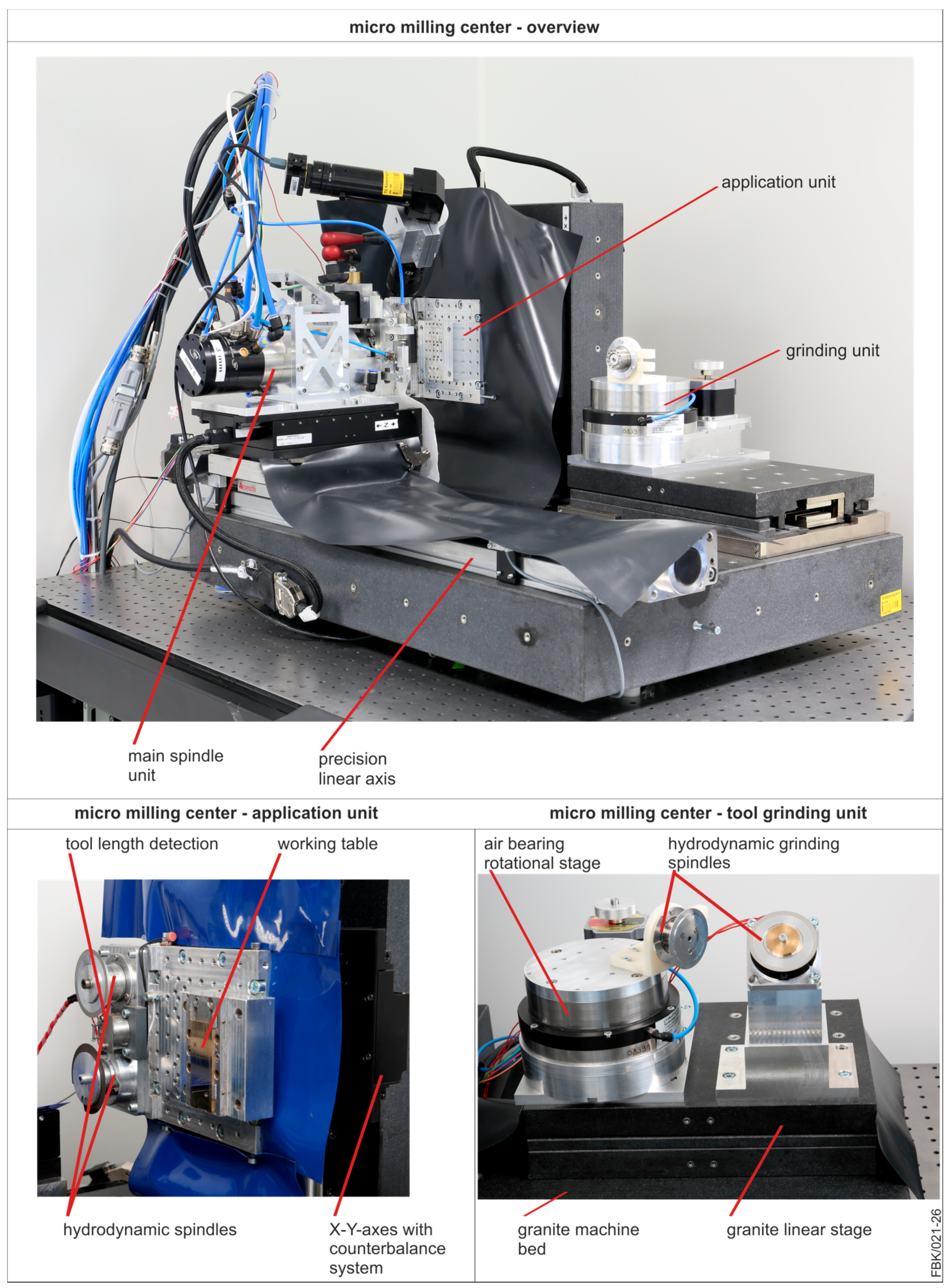

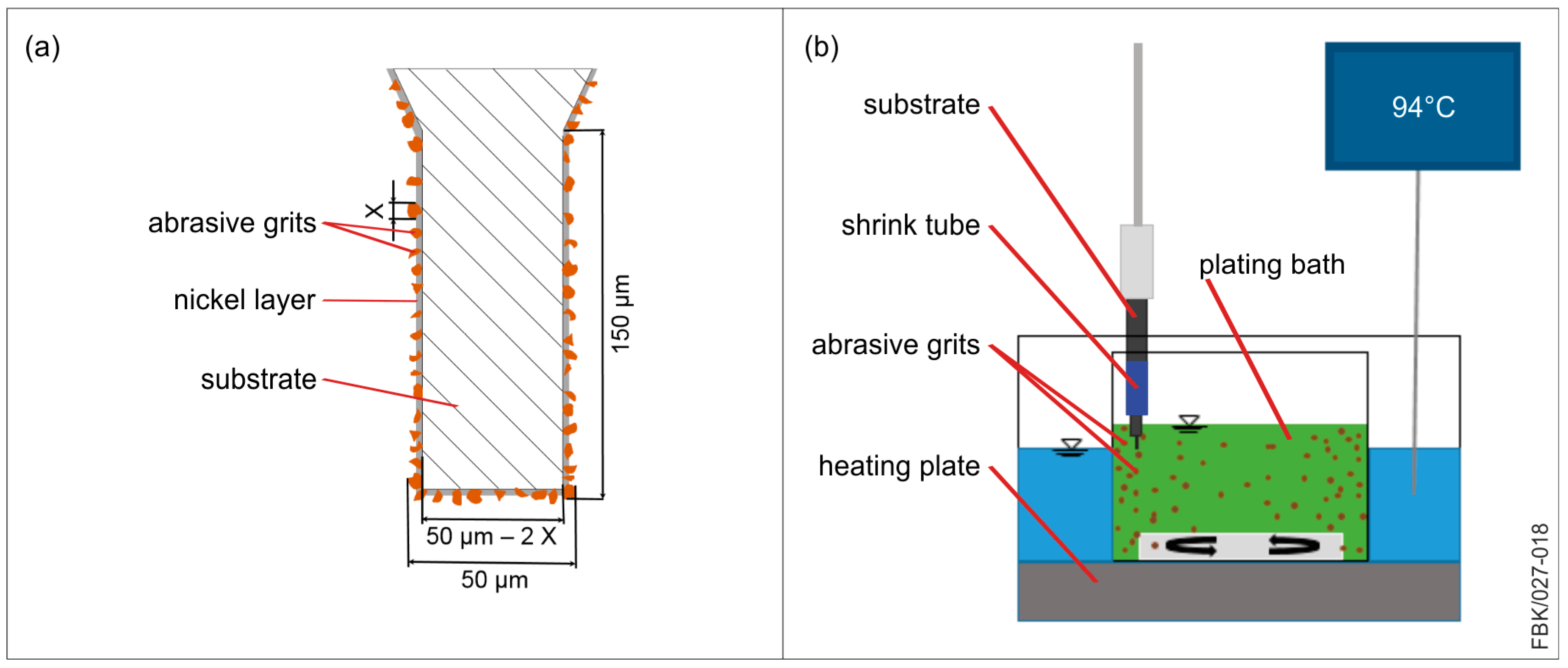
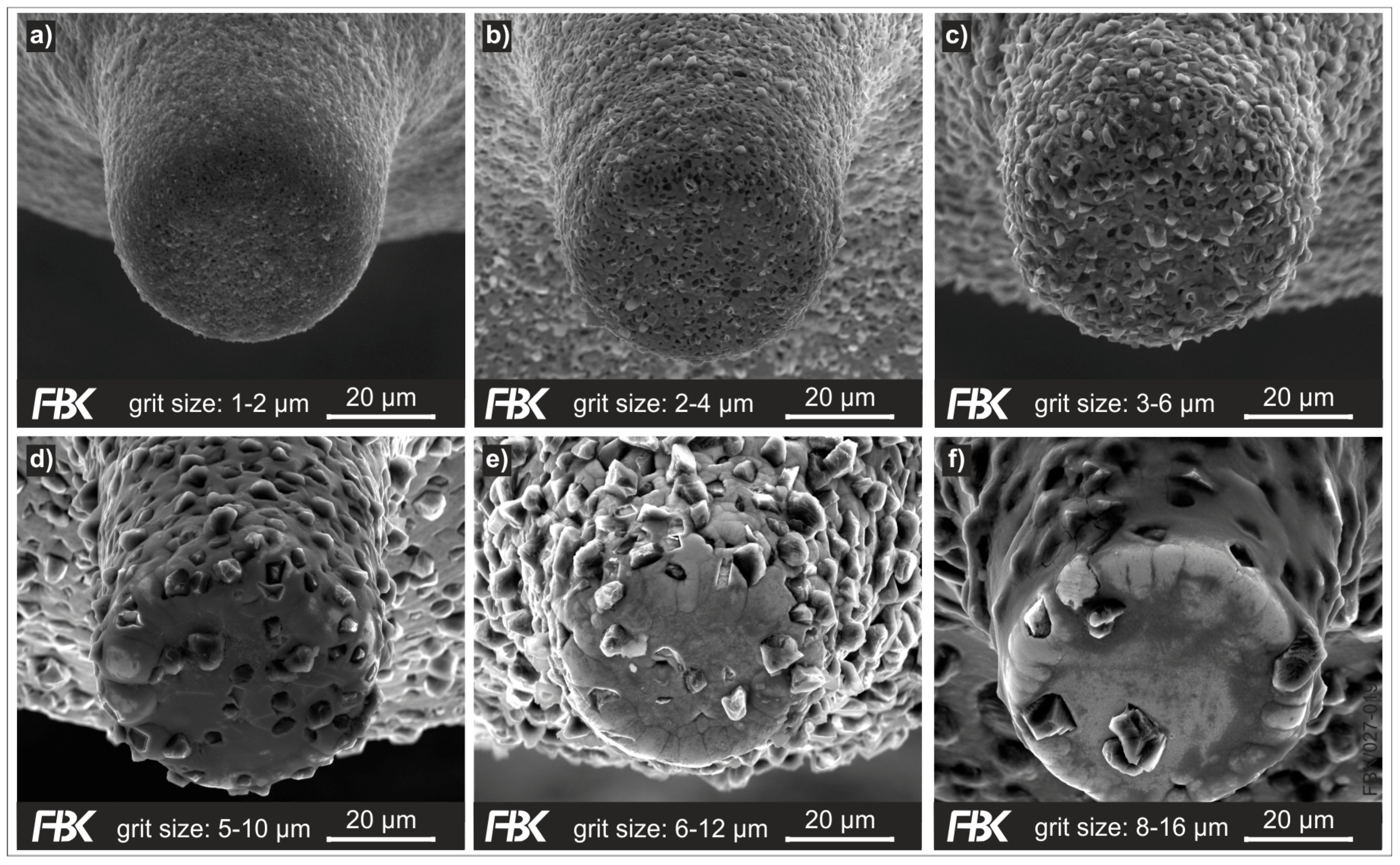


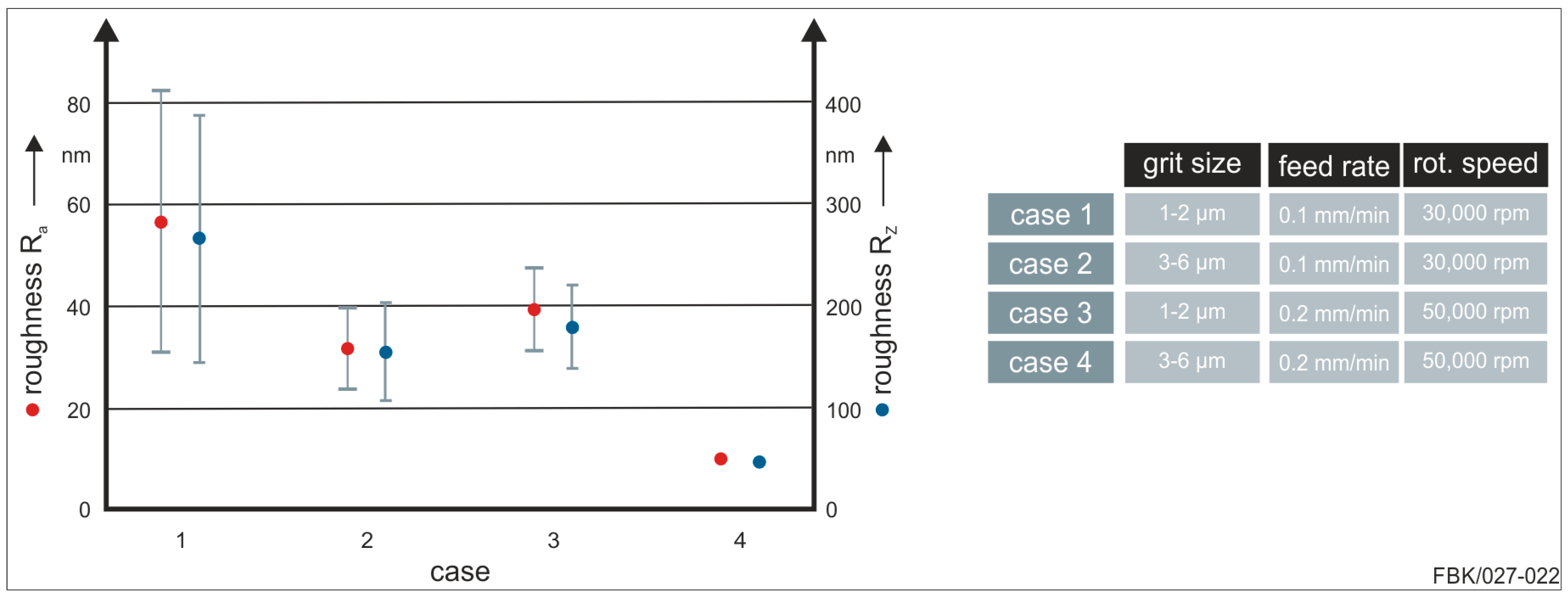
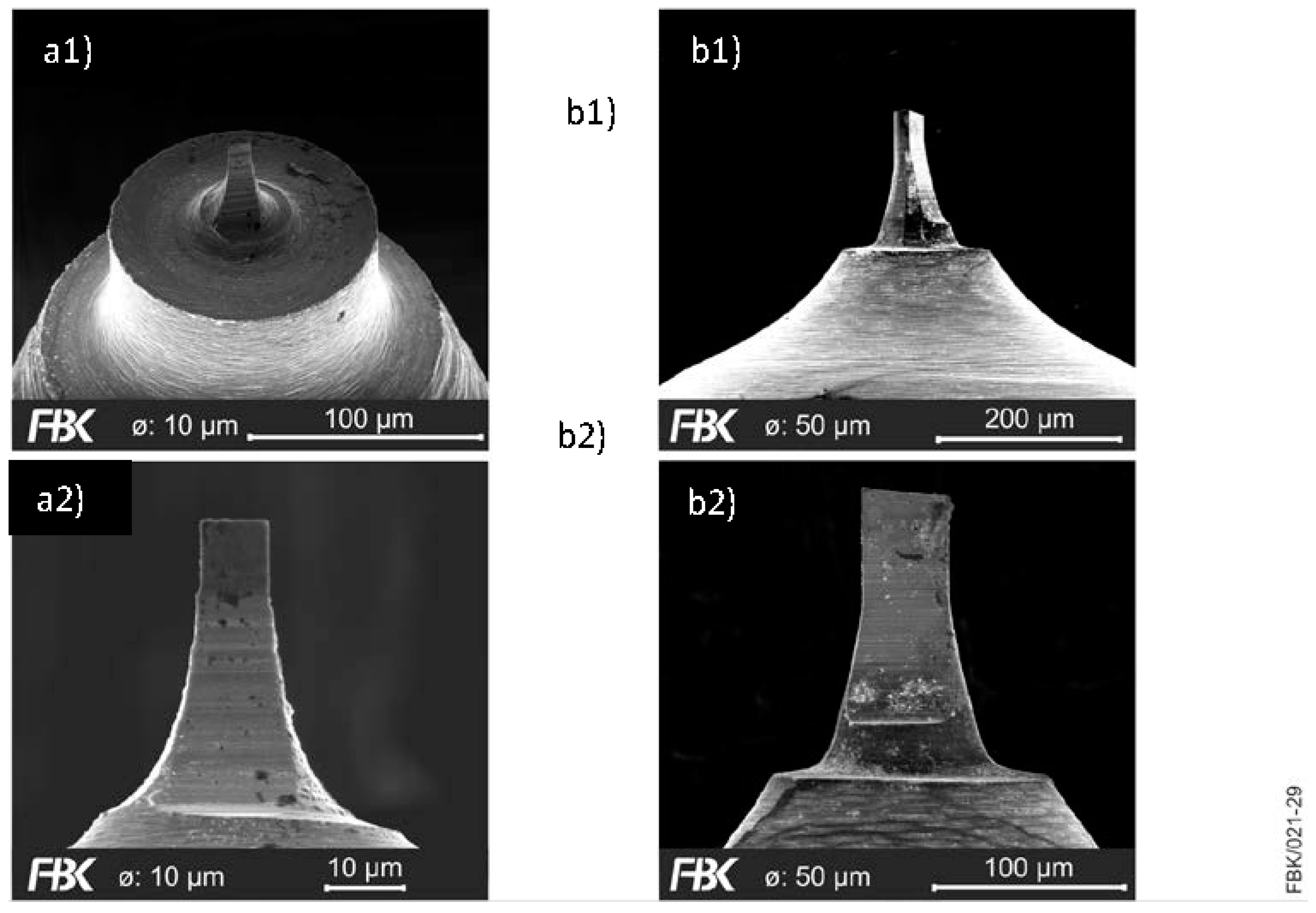
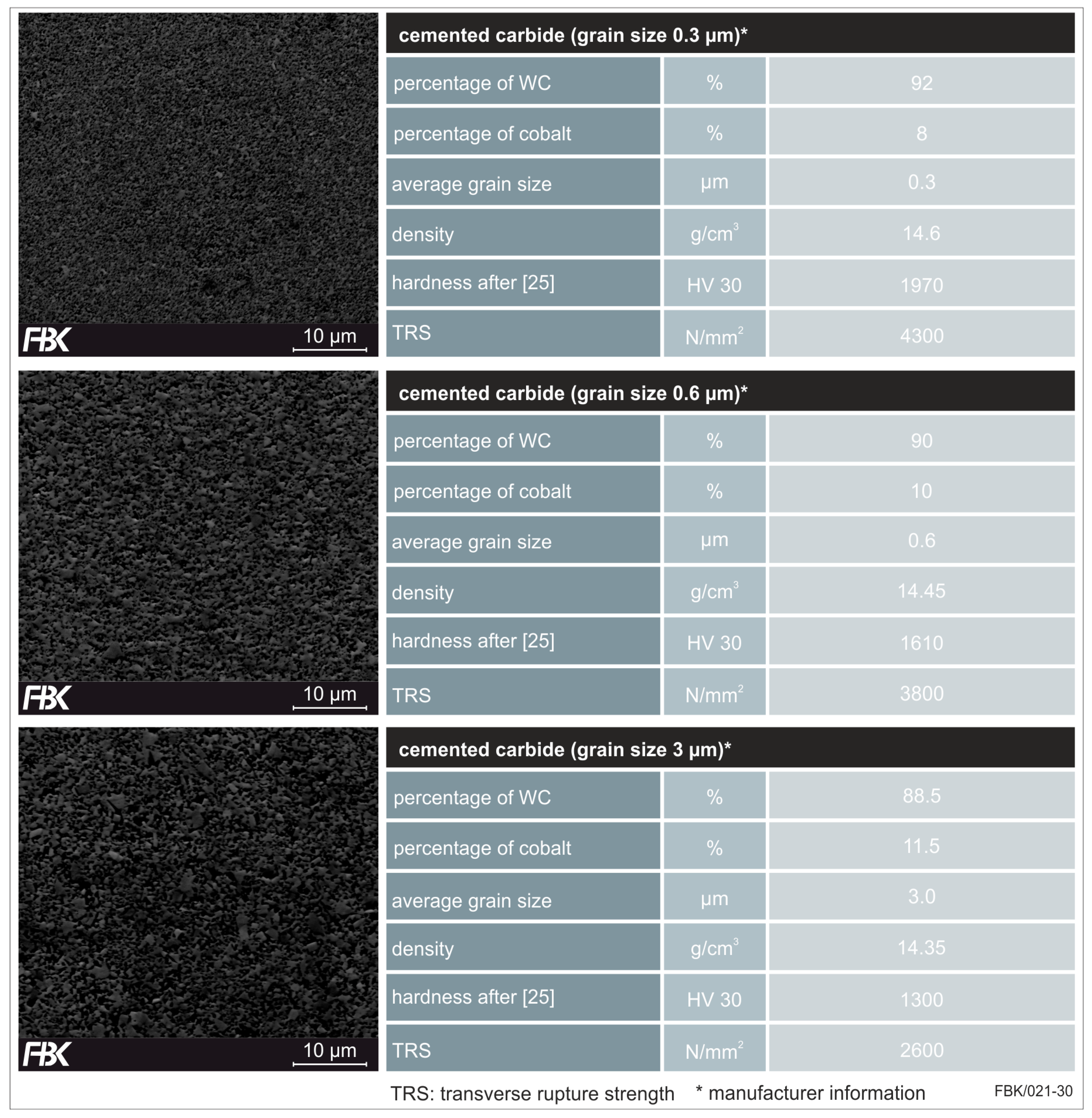
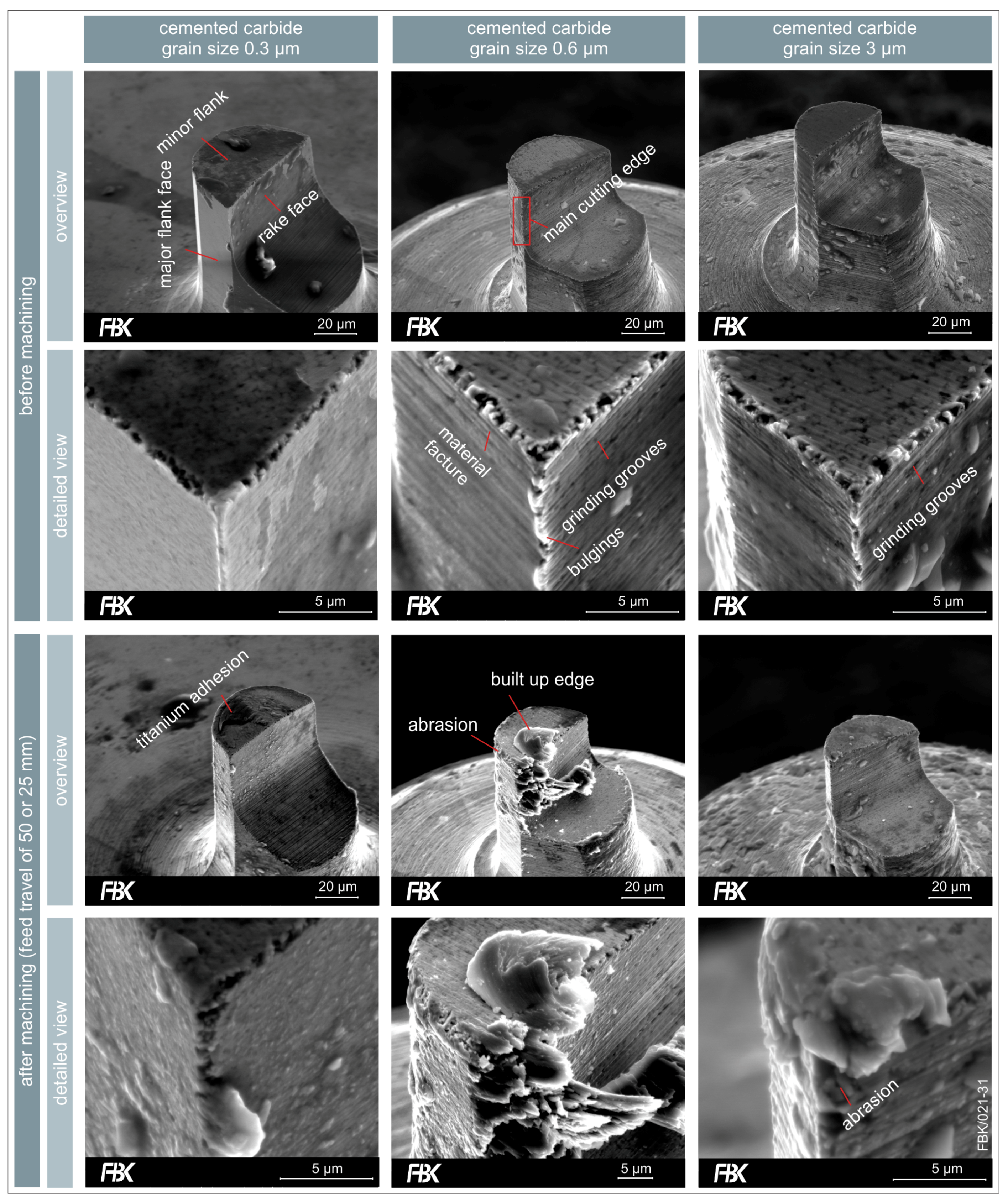
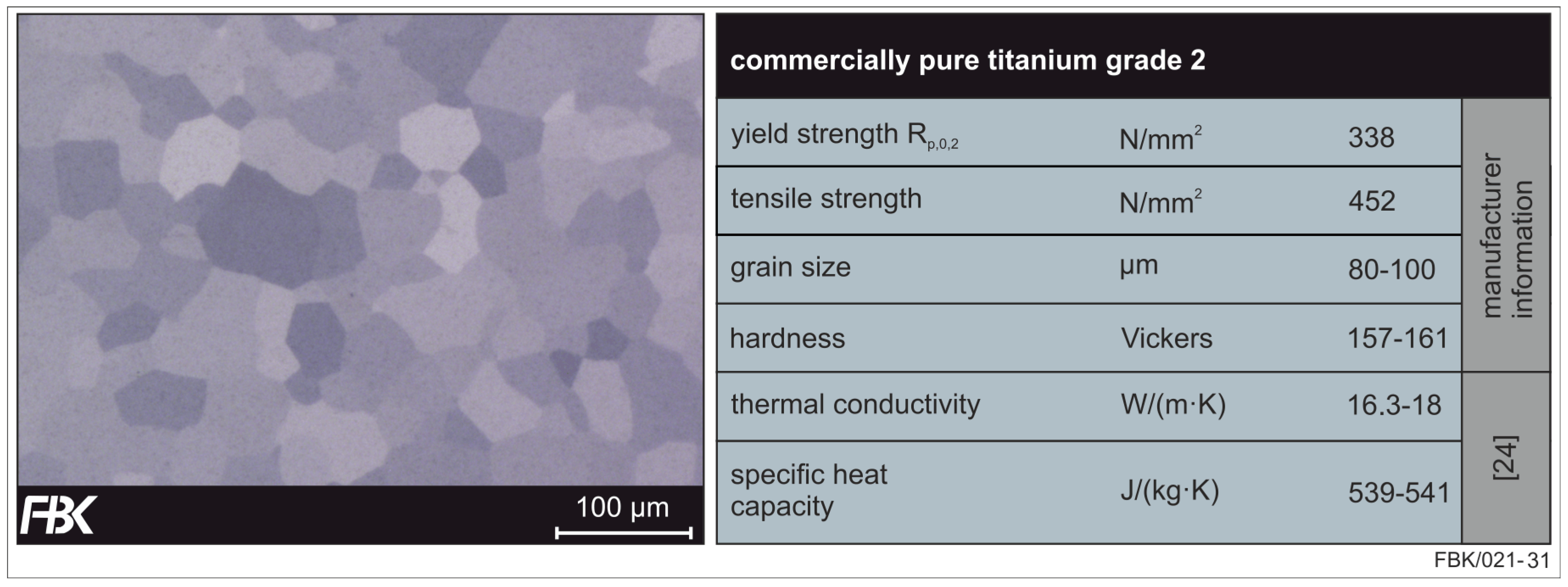

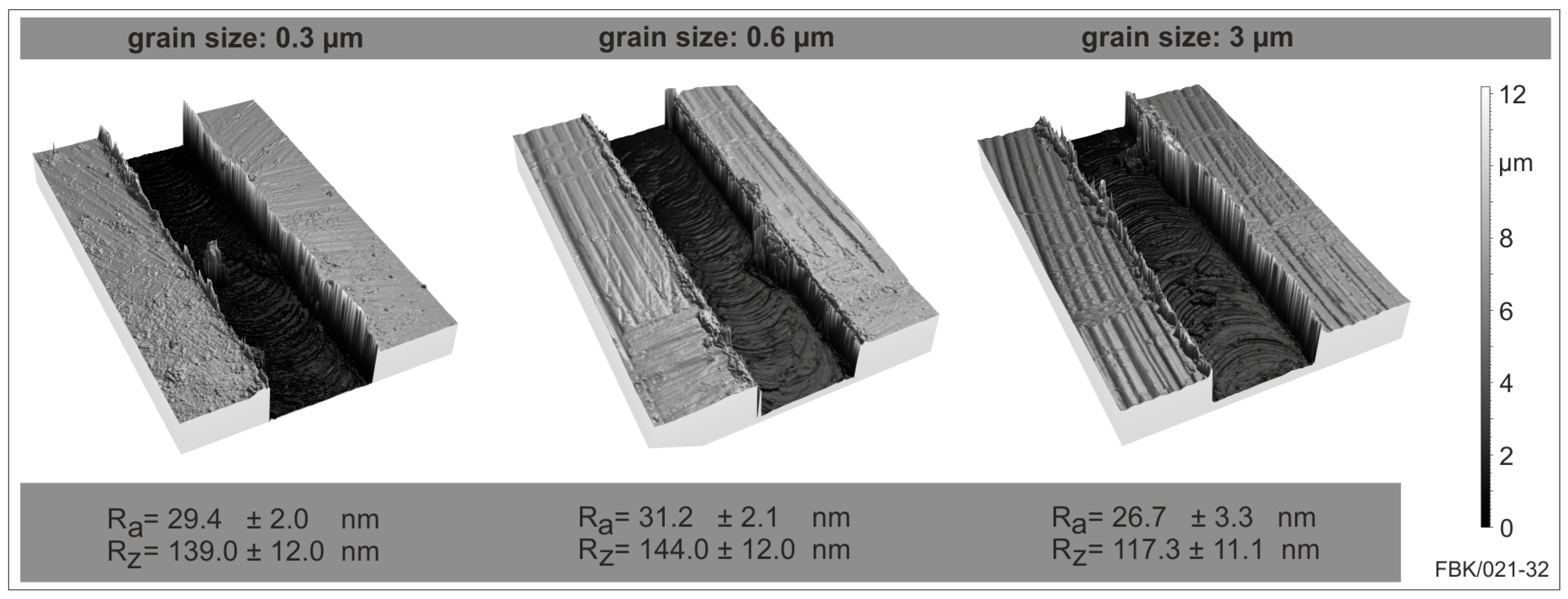
| Component | Concentration (g/L) |
|---|---|
| Nickel sulfate (NiSO4·6H2O) | 30 |
| Sodium hypophosphite (NaH2PO2) | 20 |
| Sodium acetate (C2H3NaO2) | 20 |
| Thiourea (CH4N2S) | 0.0004 |
| Hydrochloric acid (HCl) | Adapted to pH-value |
| Abrasive grits | 0–50 |
| Case | Grit Size (µm) | Main Plating Time (Min) | Embedding Time (Min) | Grit Concentration (Solution) (g/L) |
|---|---|---|---|---|
| (a) | 1–2 | 20 ± 3 | 0.5–1 | 0.5–1 |
| (b) | 2–4 | 20 ± 3 | 1.5–2 | 4 |
| (c) | 3–6 | 19 ± 3 | 2–3 | 8 |
| (d) | 5–10 | 19 ± 3 | 3–4 | 15 |
| (e) | 6–12 | 18 ± 3 | 4 | 20 |
| (f) | 8–16 | 18 ± 3 | 5 | 23 |
| Case | Grit Size (µm) | Feed Rate (mm/min) | Rotational Speed (rpm) | Depth of Cut (µm) | Groove Length (mm) |
|---|---|---|---|---|---|
| 1 | 1–2 | 0.1 | 30,000 | 5 | 1 |
| 2 | 3–6 | 0.1 | 30,000 | 5 | 1 |
| 3 | 1–2 | 0.2 | 50,000 | 5 | 1 |
| 4 | 3–6 | 0.2 | 50,000 | 5 | 1 |
© 2017 by the authors. Licensee MDPI, Basel, Switzerland. This article is an open access article distributed under the terms and conditions of the Creative Commons Attribution (CC BY) license (http://creativecommons.org/licenses/by/4.0/).
Share and Cite
Kirsch, B.; Bohley, M.; Arrabiyeh, P.A.; Aurich, J.C. Application of Ultra-Small Micro Grinding and Micro Milling Tools: Possibilities and Limitations. Micromachines 2017, 8, 261. https://doi.org/10.3390/mi8090261
Kirsch B, Bohley M, Arrabiyeh PA, Aurich JC. Application of Ultra-Small Micro Grinding and Micro Milling Tools: Possibilities and Limitations. Micromachines. 2017; 8(9):261. https://doi.org/10.3390/mi8090261
Chicago/Turabian StyleKirsch, Benjamin, Martin Bohley, Peter A. Arrabiyeh, and Jan C. Aurich. 2017. "Application of Ultra-Small Micro Grinding and Micro Milling Tools: Possibilities and Limitations" Micromachines 8, no. 9: 261. https://doi.org/10.3390/mi8090261



